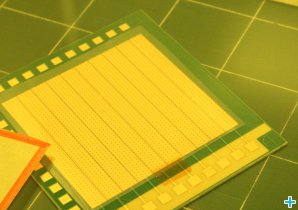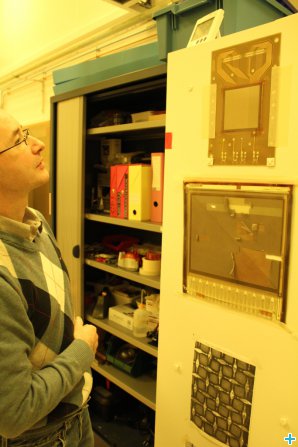On the way to more efficient boron-10 detectors
The Detectors JRA at CEA-Saclay
By Inês Crespo, Information Manager, 28/01/2014
To cope with the shortage of helium-3 (3He), European neutron facilities have decided to join efforts in a NMI3 Joint Research Activity (JRA) to investigate Boron-10 (10B) as a replacement for 3He as a neutron converter in the instruments’ detectors. The Laboratoire Léon Brillouin (LLB) has therefore proposed to the neighbour detectors team of the French Alternative Energies and Atomic Energy Commission (CEA) to build a new detector together.
Micromegas detectors
In the beginning of December I have visited the team responsible for this task in Saclay. Alain Delbart is the deputy director of the Electronics, Detectors and Computing Division (Sédi), which is one of the departments of the Institute of Research into the Fundamental Laws of the Universe (IRFU). He has kindly explained me that within the NMI3 Detectors JRA his team is investigating how to improve the efficiency of 10B detectors. Part of the Micro Pattern Gas Detectors “family” (MPGD) the micromegas (Micro-MEsh Gaseous Structure) detectors were created at CEA in 1996 by Georges Charpak, Ioannis Giomataris, Philippe Rebourgeard and Jean-Pierre Robert. In the future these detectors might be used for instance to detect illicit materials in airports.
Step-by-step towards a prototype
The 10B detectors investigated within this JRA are currently less efficient than the commonly used 3He detectors. The main challenge of this taks is thus to develop a 10B detector as efficient as the 3He ones, i.e. to significantly increase the efficiency from about 6% up to 50%.
Delbart’s team has a number of ideas on how to achieve this goal. A detector with several 10B layers (as opposed to only one layer) will make it possible to convert neutrons in each layer and consequently increase the efficiency. Through Monte Carlo simulations, they will investigate how to organise the layers in the detector and define the necessary electric field to conduct the electrons through the 10B layers and guide them to the amplification zone. Once they decide for the most suitable parameters such as thickness and distance between layers, they will build a prototype and test it in the LLB’s neutron beam.
Giorgios Tsiledakis is a PostDoc whose work is dedicated to this task. He has recently started to work with CEA and is now learning to design and build the new prototype. LLB and CEA already have the necessary tools to measure the performance of the future prototype, but the new detector needs to be tested step-by-step and thus might take up to three years to be completed.
Advantages of working as part of a NMI3 JRA
Working as part of a NMI3 JRA certainly has a number of advantages for the team in CEA. This collaboration is a good opportunity to start to investigate the detectors’ efficiency in response to the 3He shortage. The European Spallation Source (ESS) is under construction and will need large scale detectors. MPGD’s are the best option when neutron experiments demand high performances in terms of spatial or time resolution. Additionally these detectors offer a high rate and flux of particles detected. Micromegas might therefore become part of the process, especially because its manufacturing process is also fully transfered in the Printed Circuit Board Industry. The spectrum of applications of these detectors is rather large and may possibly respond to 90% of the demand. Finally, the group at CEA is involved both with the neutron and the detectors communities through NMI3 and CERN/RD51 respectively. This JRA is important to establish a connection between the two communities.
Useful links

NMI3 thanks Alain Delbart for reviewing this article.


